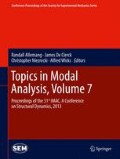Abstract
Modal testing is routinely performed on space craft and launch vehicles to “verify” (calibrate and validate) analytical models. Large multi-component structures such as the Space Transportation System (STS) or “Space Shuttle,” and the newly proposed NASA Space Launch System (SLS), are impractical to test in their assembled configurations. Alternatively, substructure testing of these multi-component structures has been performed and used to calibrate/validate analytical models of the substructures, which are then assembled to analyze system response to applied loads. This paper describes a methodology applicable to uncertainty quantification (UQ) of reduced (modal) models of linear (or linearized) finite element models of substructures, as well as reduced (stochastic neural net (SNN)) models of nonlinear substructures, such as joints. The UQ at reduced substructure levels is propagated to higher levels of assembly by efficient means, enabling predictive accuracy assessment at the coupled system level. UQ is based entirely on comparisons on analysis and test data at the substructure level so that recourse to the specification and quantification of element-level random variables is not necessary. Examples are presented to illustrate the methodology.
Access this chapter
Tax calculation will be finalised at checkout
Purchases are for personal use only
References
Craig RR, Kurdila AJ (2006) Fundamentals of structural dynamics. Wiley, Hoboken
Admire JR, Tinker ML, Ivey EW (1992) Mass-additive modal test method for verification of constrained structural models. In: Proceedings of the 10th international modal analysis conference, San Diego, CA
Gwinn KW, Lauffer JP, Miller AK (1988) Component mode synthesis using experimental modes enhanced by mass loading. In: Proceedings of the 6th international modal analysis conference, Kissimmee, FL, pp 1088–1093
Chandler KO, Tinker ML (1997) A general mass-additive method for component mode synthesis. In: Paper AIAA-97-1381, Proceedings of the 38th structures, structural dynamics and materials conference, Kissimmee, FL, pp 93–103
Hasselman TK, Lloyd GM, Red-Horse JR, Paez TL (2011) Quantification of margins and uncertainties (QMU) for integrated spacecraft system models, STTR Phase I Final Report, Report No. 11-744-1, ACTA Inc.
Hasselman TK (2001) Quantification of uncertainty in structural dynamic models. ASCE J Aerosp Eng 14(4):158–165
Guyan RJ (1965) Reduction of stiffness and mass matrices. AIAA J 3(2):380
Kammer D, Nimityongskul S (2011) Propagation of uncertainty in test/analysis correlation of substructured spacecraft. J Sound Vib 330: 1211–1224.
Lloyd G, Hasselman T, Paez T (2005) A proportional hazards neural network for performing reliability estimates and risk prognostics for mobile systems subject to stochastic covariates. In: Proceedings: ASME IMECE, Safety engineering and risk analysis/methods and tools for complex systems analysis, Orlando, FL
Bishop C (2000) Neural networks for pattern recognition. Oxford University Press, Oxford
Girosi F, Jones M, Poggio T (1995) Regularization theory and neural networks architectures. Neural Comput 7(2):219–269
Hasselman TK, Hart GC (1972) Modal analysis of random structural systems. J Eng Mech Div ASCE 98(EM3):561–579
Hasselman T, Chrostowski J (1994) Propagation of modeling uncertainty through structural dynamic models. Presented at the 35th AIAAASME/ASCE/AHS/ASC structures, structural dynamics and materials conference, Hilton Head, SC, 18–20 April 1994
Klema VC, Laub AJ (1980) The singular value decomposition; its computation and some applications. IEEE Trans Autom Control AC25(2):164–176.
Jackson JE (1991) A user’s guide to principal components. Wiley, New York
Iwan WD (1966) Distributed-element model for hysteresis and its steady state dynamic response. J Appl Mech 33(4):893–900. Trans. ASME, Vol. 88, Series E, Dec
Acknowledgements
This work has been supported by the Jet Propulsion Laboratory of Pasadena, California under a NASA STTR contract. The authors wish to thank Dr. Lee Peterson as COTR for his support and guidance on the project which addresses the quantification of margins and uncertainties (QMU) for integrated spacecraft systems. The authors also acknowledge the technical support provided by Dr. Thomas Paez who has contributed his expertise in probabilistic shock and vibration analysis, and has been very helpful in providing analytical models and software used in the numerical demonstrations.
Author information
Authors and Affiliations
Corresponding author
Editor information
Editors and Affiliations
Rights and permissions
Copyright information
© 2014 The Society for Experimental Mechanics
About this paper
Cite this paper
Hasselman, T., Lloyd, G., Schnalzer, R. (2014). Linear/Nonlinear Reduced-Order Substructuring for Uncertainty Quantification and Predictive Accuracy Assessment. In: Allemang, R., De Clerck, J., Niezrecki, C., Wicks, A. (eds) Topics in Modal Analysis, Volume 7. Conference Proceedings of the Society for Experimental Mechanics Series. Springer, New York, NY. https://doi.org/10.1007/978-1-4614-6585-0_12
Download citation
DOI: https://doi.org/10.1007/978-1-4614-6585-0_12
Published:
Publisher Name: Springer, New York, NY
Print ISBN: 978-1-4614-6584-3
Online ISBN: 978-1-4614-6585-0
eBook Packages: EngineeringEngineering (R0)

